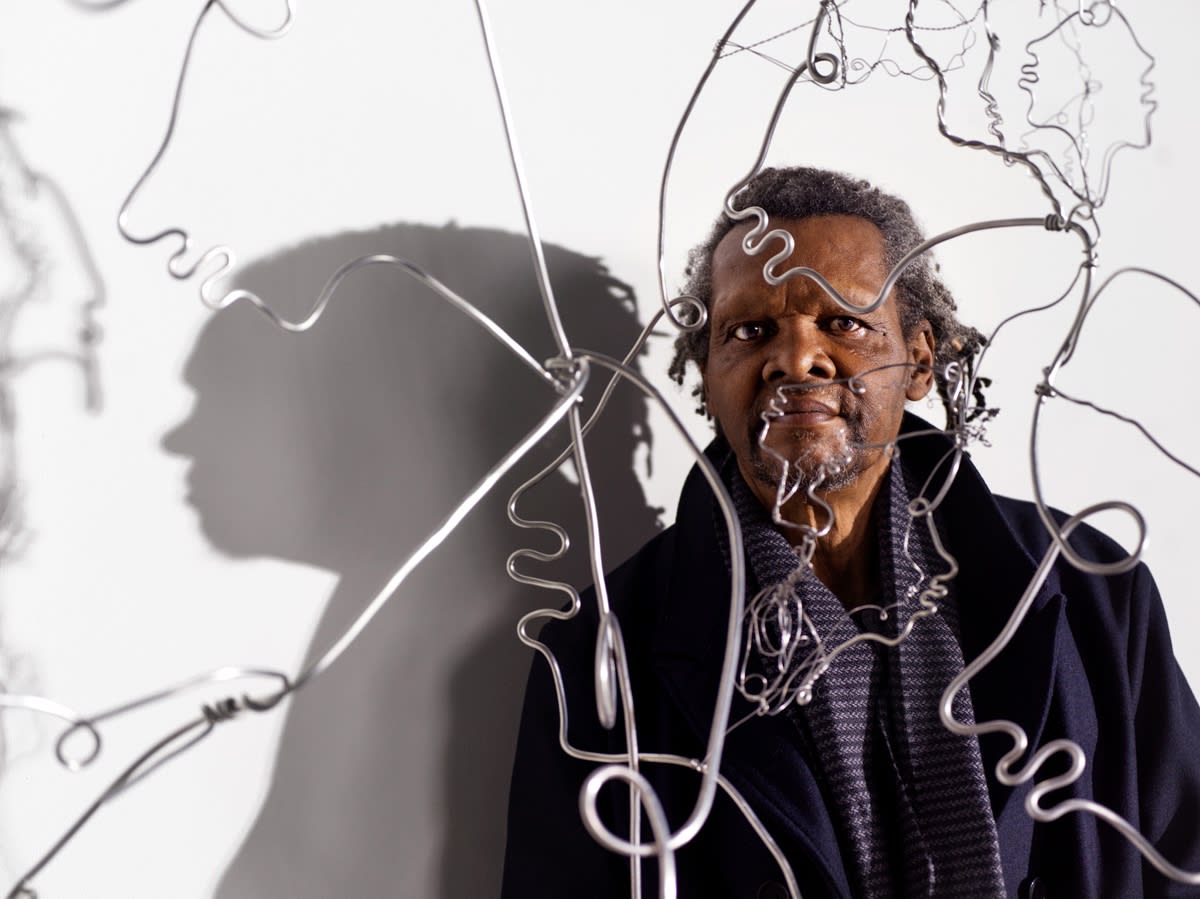21 April 2023 In both a new album and an exhibition of paintings, the artist-musician holds nothing back from voice and vision.
We are all being tested, Lonnie Holley insists in the opening lyric of his sixth and most ambitious studio album, Oh Me Oh My, which elaborates the material and psycho-spiritual aspects of the tests and cosmic obstacles he implies we cannot escape. “Testing” introduces the artist-singer’s heartbreak and near downfall as moments of potential awakening and resurrection. As with the physical assemblages he produced from the 1980s on—found scrap metal, fabric, and what some would consider detritus turned into elegiac shrines and functional structures—here he sculpts his life story in space and time, bringing the image of himself crawling around on hands and knees in quicksand into contrast with the idea of himself banished to the stillness of a statue. In 2023, we meet Lonnie Holley in this advanced stage of bloom and rebuttal; he refuses to stop testifying or to romanticize his persistence as heroism. It is a compulsion, he can’t hush, he admits on the album, which is speckled with bouts of evangelism. Like in 1979, when he began making art after carving two tombstones for his sister’s children, he is deploying all of the materials he has to accomplish what must be done. Nothing, not even his own weariness, is wasted.
Whimsy confronted with austerity at every turn is one result that shows up in the sound and texture of this album. He renders himself a scarecrow and the child in the field walking toward it with miscreant tenacity, or working his way toward it through the harvest song by song, forbidden from turning back. You hear elements of Bill Withers’s modest divinity when Holley mentions a grandmother’s hands in the second song, “I Am a Part of the Wonder.” That casual reverence for the everyday mingles and blurs with an unrelenting social bluntness reminiscent of Gil Scott-Heron, as the voice shreds and shores itself to represent the tatters of the world it’s accusing of inadequacy. That inadequacy is the muse Holley-as-narrator sets out to overcome or diminish. Oh Me Oh My enlists both living and dead artists in the delicate chemistry of collaboration to regenerate the discarded fantasies wherein that muse lurks like a boogeyman. I wanted to play / I wanted to play, Holley repeats, reassuring himself of the purity of his creative impulses. At times the voices that join him feel superimposed, like the ghost silhouettes that recur as contiguous howls in his recent series of paintings, The Eyes Were Always On Us (now on view at the UTA Artist Space in Atlanta), as if you’re eavesdropping on his hallucinations.

Lonnie Holley. Photo: David Raccuglia.
Elsewhere, the duetting voices merge with Holley’s and build an echoing, blues-operatic call-and-response that sounds insurmountably unified across genres and epochs, a sonic Watts Towers–esque set of accumulations. This is the case with the harrowing title track, on which Michael Stipe’s lilting and tormented timbre complements a relatively distressed Holley and makes space for the confessional. Holley is discussing his mother, who had twenty-seven children, of which he was the seventh, and he sounds somewhere between scornful and pleading for understanding. He sings us and himself the lullaby he was denied as a child. He was separated from his mother then, in the fraught Birmingham of the 1950s, and traded for a pint of whisky, as he tells it. Yet he enacts this reunion with vulnerability more than malice. I let ’em fall, I’ll let ’em fall, / I will let them fall, Holley abides, referring to his own tears. Stipe comes in to repeat the hook, as if to soothe that pain into submission. Holley returns to exorcize himself: the oh me and the oh my turns into the oh us, he concedes, like a child accepting that it wasn’t his fault. He enters the maternal, becomes it, makes amends with it, then lets it depart in a low-roaring hum. The silhouettes he paints in a near endless spiral throughout The Eyes seem to billow out of this song and reproduce as his bottomless capacity for re-mothering and reinventing. There is no slightness to his fertility or his mother’s, and that unquantifiable ability to recreate the self as a pattern of selves and related idioms is celebrated as both bounty and fragmentation. Look at how many people I can relate to, am related to, and all of the ways I relate, Holley could boast. Instead he demonstrates this and leaves a quiet awe.
A tone poem staggers into raging work song with “Mount Meigs,” in which Holley recounts his time in a labor camp in Alabama, picking cotton, surviving beatings and sexual violation. I was only trying to run away to find my mother, you catch him explaining between frenetic drums, picture me being there, / in Alabama Industrial School for Negro Children. The isolation of this song is refreshing. Any intervening voice would temper what needs to be unkempt emotionalism. His speech becomes crushing incantation until you picture him, as he demands, as a boy trying to escape the aggression enclosing and even enchanting him by fantasizing about reconciliation with his mother. “Mount Meigs” slurs into “Better Get That Crop in Soon,” an upbeat subsidiary work song set in the field as rain approaches like salvation from toil. It’s a modern take on “Ol’ Man River.” A dialogue with an overseer occupies the center of the song, which shutters grimly, slaves all over the field, / just looking. By this midpoint in the album, it’s clear that Holley has renounced aloofness about his past experience and will no longer spare us vivid details. This is an autobiographical work and denies listeners the decontextualized ambiguity that makes previous albums easier to appropriate and vest with arbitrary soulfulness or uncomplicated sweetness. You have to earn access to these new laments.

